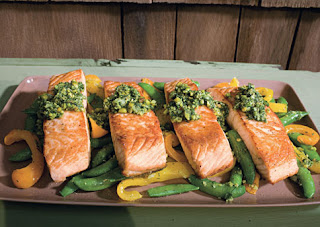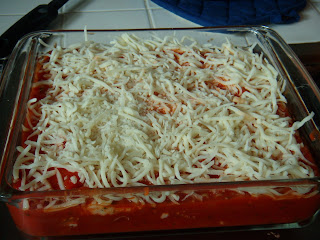French Onion Soup
Prep: 20 minutes
Cook: 50 minutes
Serves: 4
2 T butter or stick margarine
4 medium onions, sliced
2 cans (10.5 oz) condensed beef broth
1.5 C water
1/8 t pepper
1/8 t dried thyme leaves
1 bay leaf
4 slices French bread, ¾ to 1 inch thick, toasted
1 C shredded Swiss or mozzarella cheese
¼ C grated Parmesan cheese
1. Melt butter in 4-quart nonstick Dutch oven over medium-high heat. If desired, cook onions in 12-inch nonstick skillet; after cooking, transfer onions to Dutch oven to complete the soup. Stir in onions to coat with butter. Cook uncovered 10 minutes, stirring every 3-4 minutes.
2. Reduce heat to medium-low. Cook 35-40 minutes longer, stirring well every 5 minutes, until onions are light golden brown (onions will shrink during cooking.)
3. Stir in broth, water, pepper, thyme and bay leaf. Heat to boiling; reduce heat. Cover and simmer 15 minutes. Remove bay leaf.
4. Set oven to broil. Place bread in 4 ovenproof bowls or in individual casseroles. Add onion soup. Top with Swiss cheese and sprinkle with Parmesan cheese. Place bowls on cookie sheet or in pan with shallow sides.
5. Broil with cheese about 5 inches from heat 1 to 2 minutes or just until cheese is melted and golden brown. Watch carefully so cheese doesn’t burn. Serve with additional French bread, if desired.
I think with this recipe, I was so excited to make it that I didn't slow down the process enough and consider it from all angles. First, I was so focused on just getting the onions sliced that I didn't ensure they were sliced thin enough and that all slices were made with a cut of the same width. Looking back, some slices were cut perfectly and some were cut a little on the wide side, so the end result when they were all in the pan was that some cooked too fast and some didn't get the full amount of cooking time required. The thinnest slices were starting to burn just as the thicker slices were turning that nice golden brown that is evident of French Onion Soup. So that was an issue.
The other thing was that when I was in the store, I decided I really didn't want to buy a whole loaf of French bread just for the two slices required for this recipe. I decided to use some whole wheat sandwich buns I already had. Wrong! Even after toasting said sandwich buns, they immediately began to get soggy upon putting them in the bowl with the soup, plus the buns were nowhere near dense enough to match French bread. Most unfortunate.
And going back to the onions, I opted to cook them in a non-stick skillet before putting them in the soup pot. Once they were done, or more precisely, once I could see that any further cooking would result in some incinerated onion slices, I put them into the pot with the broth and other ingredients.
I also used slices of Provolone to top the soup instead of Swiss cheese, simply because I had Provolone on hand. It was good and I could tell no difference between that type of cheese and any other that would be appropriate for this soup. It's gooey - it's melty - it's good.

The ultimate decision, however, is how the soup tasted. It was... okay. Not mind blowing. Much better than the restaurant soup that I had, but still not awesome. It was the onions and the soggy bread that really sealed the deal. However, this can easily be remedied to make a better soup next time. I really want to perfect this before fall.






